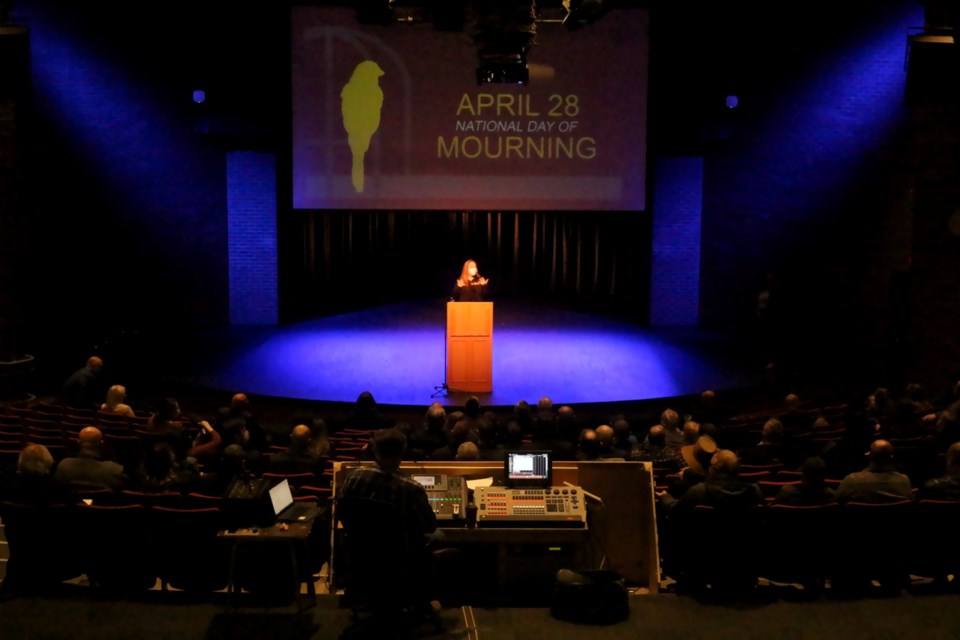The Sudbury and District Labour does not accept that thousands of workers are dying every year, and hundreds of thousands more are injured or made sick as a result of their jobs, said the organization’s president.
Jessica Montgomery, president, Sudbury and District Labour Council, hosted this year’s National Day of Mourning at Laurentian University.
Now an international observance as a day of mourning for workers killed, injured or made ill by their job, the declaration of April 28 as the Day of Mourning began here in 1984 when unions adopted the day as one to publicly acknowledge workplace injuries, illnesses, and deaths.
“The enduring April 28 call to mourn the dead and fight for the living is still relevant, and still urgent, especially with the pandemic,” Montgomery said.
It has been just over two years since the World Health Organization declared the COVID-19 global pandemic, and in that time, there have been more than 3.5 million recorded cases of COVID-19 and 37,728 deaths, she said.
Meanwhile, workers continue to be injured, made sick or killed from unsafe working conditions and a range of hazards, she said.
“Three years ago, the international labour organization recognized occupational health and safety as a fundamental right at work, yet it remains outstanding,” she said. “In those three years, more than nine million people have died because of their work, and many more now live with life-altering diseases or injuries because their employer failed to protect them.”
In Canada, about 1,000 workers’ deaths per year are recognized by worker compensation boards, “and we know that’s just the tip of the iceberg,” Montgomery said.
In 2019, the most recent year for which statistics are available, there were 925 accepted workplace fatalities, and 271,806 accepted lost-time injury claims.
“These are only a fraction of the true toll,” Montgomery said. “We do not accept that thousands of workers are dying and hundreds of thousands more are injured or made sick every year as a result of their jobs. Health and safety must be a priority in the workplace, and not the occassional afterthought
In 2020, CBC reported about a cluster of occupational diseases that have surfaced among former employees of Neelon Casting. The company operated for more than 30 years in Sudbury, and closed in 2007.
One of those employees is Daryl Park. He’s now retired, but recalled a number of stories from his days at Neelon Casting.
During its operation, Neelon employed more than 2,000 unionized employees and many staff and management, Park said. It enjoyed quite a bit of success. At one point, it manufactured all of the rotors in North American for Mercedes-Benz, right here in Sudbury
“We were pretty proud of that,” he said.
It’s the working conditions at the foundries that is the dark side of the story, he said.
“I visited numerous foundries over the years, and they all have a number of things in common — they are dusty, dirty and very hot places to work,” he said. “The work is labour intensive, heavy and monotonous.”
There were many health and safety issues, he said. For example, in the core room, where they manufactured the inner sand cores for the castings, the materials used in this process involved gases that caused numerous headaches for the employees.
Park said after working his shifts, they would see blue halos around lights for several days, and his wife and friends would often ask him about the smell that emanated from him. It was the gases escaping his body.
Headaches and fatigue were common. Often, workers would fall asleep on the job, he said. It was actually discovered that CO2 levels in one of their shops exceeded 1,000 parts per million (PPM), far above the acceptable level of 250 parts per million, and that’s in a one-hour period, where we worked eight-hour shifts, he said.
He became emotional when relaying the story of someone who died because he worked at Neelon.
“I have seen many of my fellow workers die early deaths in their 50s and early 60s, even as early as in their 40s,” he said. Tony, who worked in our core room for six years, at the age of 28, he developed terminal cancer and died within a year. All the physicians told his wife was that it was work related. No compensation ever came, and she was left to take care of herself and their three year old son.
“Years later, that young man entered the program I was teaching at Cambrian College and asked me if I had ever worked with his dad. It was a privilege to tell him his father was a wonderful worker and very much loved by those he worked with.”
Andréane Chénier is a national representative specializing in health and safety for the Canadian Union of Public Employees (CUPE).
Chénier said occupational disease fatalities outnumbers traumatic fatalities in each of the last 10 years and many more work-related illnesses and deaths go unreported.
This year also marks the 30th anniversary of the Westray mine disaster and 18 years since the implementation of the Westray Bill.
“Those changes in law are intended to protect workers from preventable workplace injuries and illnesses, and to act as a deterrent, imposing harsh consequences on companies that failed in their duty of care,” she said.
In the 18 years since, these changes should have been making a difference, yet, each year, about 1,000 Canadian workers still die each year, she said.
“That consistency hasn’t really changed, and in Canada, we aren’t doing better since the Westray Bill came into effect. In fact, we’re doing worse.”
But how do we change this going forward?
“Workers cannot afford willful ignorance,” she said. “work shouldn’t hurt. When it does, we must look for, find and face the challenges head on to find solutions.”
